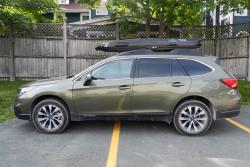 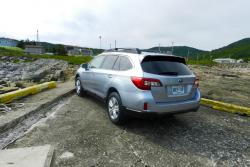 2015 Subaru Outback. Click image to enlarge |
Review by Jacob Black, photos by Jacob Black and courtesy of Subaru Canada
Originally published July 14, 2014.
It has been 20 years since Subaru unleashed the Outback on an unsuspecting North American market. Back then, Subaru sold some 4,000 units a year – now, it sells closer to 40,000 – and Subaru says Outback is a big part of that growth.
In a market that also has the Forester, some might argue that the Outback is superfluous, but Subaru has improved the demarcation between the two lines by increasing Outback’s cargo length and overall cabin size – further setting it apart from the Forester and pushing the Outback more into crossover territory and the Forester into SUV configuration. When the larger, current-generation Outback debuted in 2010 it triggered a doubling in Outback sales – bigger, it seems, is better.
Always a difficult car to categorize, the Outback is its own deal – neither car, nor wagon, nor SUV. Subaru took pleasure in pointing out that RAV4 and CR-V came after it. So if anything, Outback was the first of the crossovers by Subaru’s logic. And I can see their point. In an effort to gain a bit better perspective on the Outback niche, Subaru told us the previous model was benchmarked against cars like the Toyota Venza, this more recent edition is targeted at the Audi Allroad and the Volvo XC70.
The Outback has always enjoyed a good reputation for capability, value and reliability, but like many Subaru products has suffered from poor interior quality, a below-standard HMI and audio/infotainment system and dull styling. To Subaru’s credit, they didn’t shy away from those facts during the morning presentation, and instead told us they had worked steadfastly to resolve them in this model.
And they have succeeded.
I gave Subaru a total pasting for its backwards interior in my XV Crosstrek test drive review, but I no longer have any such complaints. This system is intuitive, feature-packed, slick, stylish and cool. There are some notable similarities with the new Toyota units but there will be more on that in a separate story.
Subaru has also worked to capitalize on their reputation for capability by offering the same X-Mode system as seen on the 2015 Subaru Forester. The system improves off-road capability by providing better traction to the wheels when one or more of them is rendered useless by say – being off the ground, or being stuck on a bit of mud. I’ll quote our esteemed Senior Editor Jonathan Yarkony for a more detailed explanation:
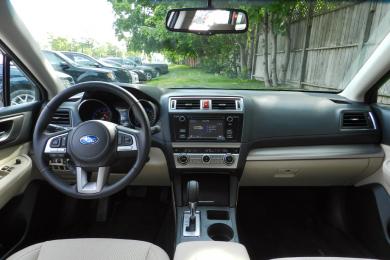 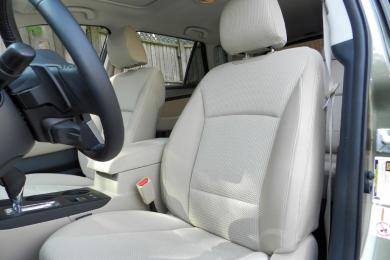 2015 Subaru Outback dashboard & seat detail. Click image to enlarge |
“Throttle response is reduced for greater control, AWD clutch pressure is increased to better control speed differential between front and rear axles, lower transmission ratios are maintained and the torque converter will not lock up. Subaru’s VDC (Vehicle Dynamic Control, Subaru-speak for stability control) plays its part as well, braking a spinning wheel in order to keep torque flowing to the wheel on the opposite side, and controlling all braking functions to ensure a steady crawl with its hill descent control function. X-Mode will operate at speeds up to 40 km/h, then it will automatically shut off and revert to Subaru’s standard AWD.”
We were taken to an off-roading course near St John’s in Newfoundland for an explanation, and while it wasn’t as extreme as the one chosen by Jeep for their 2014 Jeep Cherokee launch event, I came away equally impressed.
The Outback has the same 220 mm of ground clearance as the Forester, but due to longer overhangs has slightly lower departure and approach angles. If you take a look at the photos you’ll get a good sense, and Subaru said they would describe departure and approach angles as “sufficient”.
(Update: The approach angle on the 2015 Outback is 18.4 degrees. The break-over angle is 20 degrees and the departure angle is 22.7 degrees.)
The ride across rough roads is incredibly comfortable too; but that does impact performance on the bitumen.
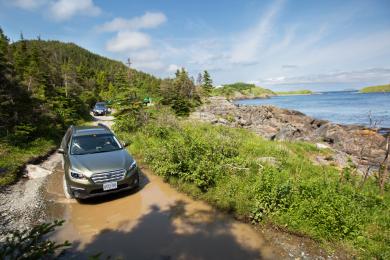 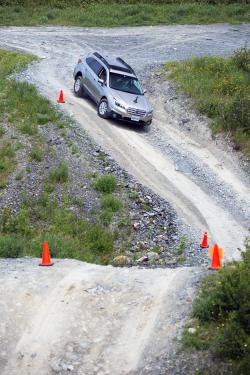 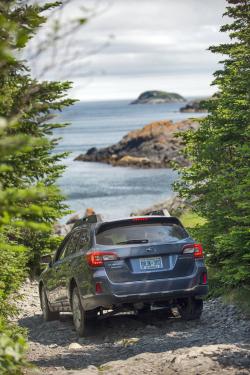 2015 Subaru Outback. Click image to enlarge |
Because the suspension is so soft, and because there is a lack of rebound damping – presumably to help cope with those rough roads – the Outback has a large amount of body roll. Less than the previous model according to the engineering data we were shown, but still more than I was comfortable with on the road. More rebound damping would make the Outback more composed in corners and over large bumps on the highway too. It turns in fine, and the electric steering is well-weighted with good communication, but the sponginess of the suspension and the propensity for bump steer mean you won’t be carving corners on mountain roads.
We had a brief stint on a mild gravel road to just to see how the Outback performed – it was great in a straight line but I couldn’t get comfortable enough to push at speed. Then again, that’s what the WRX is for…











